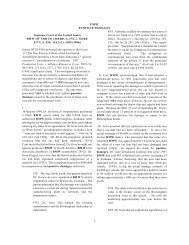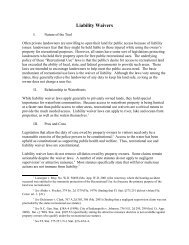The Shackling of The Shackling of Juvenile Offenders: Juvenile ...
The Shackling of The Shackling of Juvenile Offenders: Juvenile ...
The Shackling of The Shackling of Juvenile Offenders: Juvenile ...
You also want an ePaper? Increase the reach of your titles
YUMPU automatically turns print PDFs into web optimized ePapers that Google loves.
CCF also observed the overall demeanor <strong>of</strong> the defendants. For these observations, demeanor<br />
was described as either: compliant, withdrawn, defiant, or aggressive. 36 Most <strong>of</strong> the defendants,<br />
regardless <strong>of</strong> charge or hearing result, were rated as compliant (93%). Four percent (4%) <strong>of</strong><br />
the defendants were rated as withdrawn, while only one percent (1%) was rated as defiant. One<br />
individual was rated as aggressive, and a second person was rated as having an “emotional outburst.”<br />
Mirroring the results <strong>of</strong> the full group <strong>of</strong> defendants, 94% <strong>of</strong> those who were shackled at<br />
the leg only were compliant, four percent (4%) were withdrawn, and one percent (1%) was defiant.<br />
Only one defendant in this category was rated as aggressive. Of the three percent (3%) who remained<br />
fully shackled throughout the court proceedings, 75% <strong>of</strong> the defendants who were shackled<br />
at the hands and legs throughout the proceedings were rated as compliant, and 25% <strong>of</strong> defendants<br />
in this category were rated as withdrawn. Thus, the court room behavior <strong>of</strong> the children who were<br />
un-cuffed at the hands was statistically no different than the behavior <strong>of</strong> those who were completely<br />
shackled or <strong>of</strong> those who were un-cuffed (95% compliant, 3% withdrawn, and 2% defiant).<br />
Although CCF also considered charges and hearing results, we found no differences in the behavior<br />
<strong>of</strong> defendants who were shackled at the legs only as compared to those who were un-cuffed or<br />
shackled at the hands and legs, related to these factors.<br />
California, Connecticut, Illinois, New Mexico, North Dakota, North<br />
Carolina, Oregon, and Vermont do not shackle juvenile defendants<br />
as a result <strong>of</strong> State Supreme Court rulings or legislative action.<br />
9

















